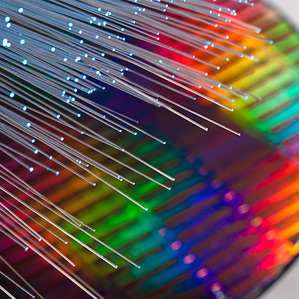
Intel hopes to make computing far more efficient by introducing a technology that replaces conventional copper data cables with faster optical data links. The breakthrough required Intel to fit lasers and other optical components onto silicon chips, which usually deal only with electronic signals.
The initial version of what Intel calls its silicon photonics technology can transmit data at speeds of 100 gigabits per second along a cable approximately five millimeters in diameter. Intel will offer it for use connecting servers inside data centers, where it can take the place of PCI-E data cables that carry data at up to eight gigabits per second and networking cables that reach 40 gigabits per second at best. The latest version of the USB standard common in consumer gadgets can move data at only five gigabits per second.
“We’re launching this in mass production, and Intel has decided to make a significant investment,” says Mario Paniccia, who has led Intel’s silicon photonics research for years and now heads the group commercializing it. “We have lots of customers.” Future versions of the technology are intended to appear outside data centers, perhaps in consumer applications.
Intel’s technology can significantly reduce the costs of running a data center—the large computing clusters that crunch data, run apps, and host websites. That’s because one of Intel’s new optical cables can replace 10 or more of the relatively bulky PCI-E copper cables that connect servers stacked on the same rack. Those cables impede the flow of air used to cool servers. Data centers vary in their efficiency, but it is typical for cooling to account for roughly half the cost of running a data center.
Intel’s silicon photonics technology can also be used to replace conventional Ethernet networking cables. It could allow companies to rethink established ways of organizing computers inside data centers.
Intel has developed a small circuit board that can be added to a server to upgrade it to the optical technology. The most important part of it is a compact module containing one or more silicon chips (Intel won’t say how many) that can convert back and forth between a computer’s electronic signals and optical ones able to travel down a fiber. Among the optical components inside the chips are four silicon lasers that can each stream data at a rate of 25 gigabits per second. A card can have more than one of those optical chips on it, depending on how much bandwidth is needed. Intel worked with Corning, best known for inventing the Gorilla Glass used in many mobile devices, to develop new connectors and cables to link up the new optical boards.
The current form of the technology was shaped by feedback from companies including Facebook, Microsoft, and cloud hosting company Rackspace, some of which have committed to using the technology, says Paniccia. Pricing and availability of the technology has not been announced, but it could create a significant new income stream for Intel. In 2012, a total of 8.1 million servers were shipped worldwide, according to IDC, and many companies such as Amazon, Apple, and Facebook are investing heavily in data centers (see “Inside Facebook’s Not-So-Secret New Data Center”).
Intel is also working with operators of extremely powerful computer clusters and super computers, including unspecified U.S. government agencies. Intelligence agencies such as the National Security Agency and CIA are known to use high-powered computers to process and analyze data collected through surveillance.
Today servers are self-contained computers with processors, memory, and storage that inhabit a single layer of a server rack. The bandwidth boost from silicon photonics makes it possible to instead fill a whole layer of a rack with processors, another with memory, and a third with storage. That can make upgrades faster and help make better use of cooling by directing it onto the components that need it most, says Pannicia.
Some of Intel’s partners are considering a more extreme version of that approach. It would see memory, processors, and data storage being kept in entirely separate cabinets, all linked with optical connections. That could allow further improvements to maintenance and cooling. It could also permit memory to be “virtualized” so that it is dynamically allocated to software and servers as needed, a more efficient approach than having it bound to specific servers.
Read more at: http://www.technologyreview.com/news/518941/intels-laser-chips-could-make-data-centers-run-better/

No comments:
Post a Comment